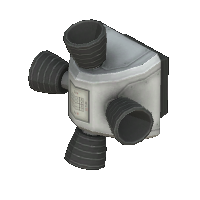Difference between revisions of "RV-105 RCS Thruster Block"
m (*general links and not to specific parts;) |
m (*use outsourced infobox;) |
||
| Line 1: | Line 1: | ||
| − | {{ | + | {{:RV-105 RCS Thruster Block/Box}} |
| − | |||
| − | |||
| − | |||
| − | |||
| − | |||
| − | |||
| − | |||
| − | |||
| − | |||
| − | |||
| − | |||
| − | |||
| − | |||
| − | |||
| − | }} | ||
The '''RV-105 RCS Thruster Block''' is used for spaceship rotation and translation movement and is fueled by a [[RCS#Fuel|RCS fuel tank]]. | The '''RV-105 RCS Thruster Block''' is used for spaceship rotation and translation movement and is fueled by a [[RCS#Fuel|RCS fuel tank]]. | ||
Revision as of 12:00, 13 July 2013
| RV-105 RCS Thruster Block | ||
| Reaction Control System by STEADLER Engineering Corps | ||
| Radial size | Radial mounted | |
| Cost | (total) | 45.00 |
| Mass | (total) | 0.040 t [1] |
| Drag | 0.1 [1] | |
| Max. Temp. | 1500 K | |
| Impact Tolerance | 15 m/s | |
| Research | | |
| Unlock cost | 1 200 | |
| Since version | 0.11 | |
| Part configuration | rcsBlockRV-105.cfg | |
| Maximum thrust | (1 atm) | 0.42 kN |
| (vacuum) | 1.00 kN | |
| Isp | (1 atm) | 100 s |
| (vacuum) | 240 s | |
| Fuel consumption | 0.11 | |
| Thrust vectoring | No | |
| Packed volume | 40 l | |
| ||
The RV-105 RCS Thruster Block is used for spaceship rotation and translation movement and is fueled by a RCS fuel tank.
Contents
Usage
RCS thrusters are used to rotate and translate the ship, and can do so outside of the atmosphere unlike canards and control surfaces. They need fuel from an RCS fuel tank]] but do not need to be placed on the tank itself, unlike the larger engines. When you don't want to spend fuel you can toggle the RCS thruster system on and off with the R key. RCS thrusters work together with the command module's control moment gyroscopes and the Advanced S.A.S. system.
The little cold gas thrusters are still powerful enough to be used instead of liquid engines for major orbit changes with smaller ships. This capability is useful for docking. For adjusting heading, it is helpful to have the S.A.S. on to prevent unwanted rotation.
The positioning of your RCS thrusters is very important. They should be placed as far from the center of mass as possible to give them maximum leverage. You should mount at least 4 RCS thruster blocks around the nose and tail of large rockets. Beware, they will be fatally damaged if they brush against the ground.
Description
In real life, RCS stands for Reaction Control System, a name for the system used to control the attitude of a spacecraft rather than its orbital velocity.
| “ | The recent discovery of a third law of physics made it possible for STEADLER Corps engineers to produce these small monopropellant thrusters, to help with attitude control and linear motion. Even though many Kerbal physicists still dispute the validity of this new law, studies show that the thrusters seem to work as advertised. — STEADLER Engineering Corps |
” |
The third law of physics referenced in the quote is likely a reference to third law of motion, which says that every force generates an equal counter-force. That's exactly how monopropellant thrusters (or rather any kind of rocket thrusters) work: when expelling propellant with a specific force, an equal force pushes the spacecraft in the opposite direction.
Trivia
Between their introduction in 0.11 and 0.17.1 (including the old 0.13.3 demo), all RCS blocks were massless and dragless, despite the CFG file values. Since 0.18 (including the new 0.18.3 demo), RCS blocks have the expected mass values.
Changes
- Nominal performance increased, bug providing vastly superior linear performance removed.
- Retextured, given Isp values and actual mass.
- Initial Release
